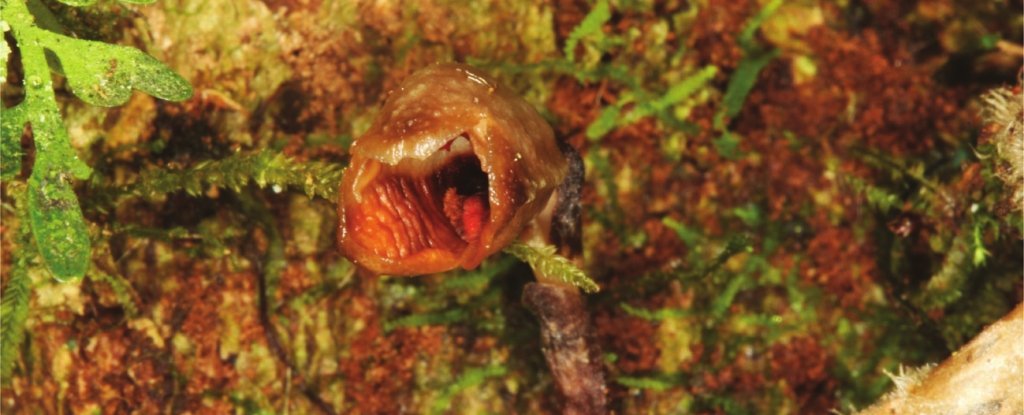
Beauty may be in the eye of the beholder, but a newly discovered orchid is probably not the best choice for many as a centerpiece.
Gastrodia agnicellus, from the forests of Madagascar, received the label of the ugliest orchids in the world by botanists at the Royal Botanic Gardens, Kew in Great Britain.
And yet the plant is fascinating, unusual among orchids and indicates how much we might miss what is hidden in the thicket.
In turn, this highlights the importance of protecting the environment: although it has just been discovered, G. agnicellus it is already considered an endangered species.
It seems reasonable that the plant was not recognized until September last year. G. agnicellus it spends most of its life buried underground, appearing in August and September only to bloom and bear fruit under the humus of leaves on the forest floor before disappearing underground again.
And those flowers are small – only 11 millimeters (0.43 inches) long – and indescribable against soil residues, ranging in color from brown to white. Even so, the flower had been found before; It’s just that no one realized the significance until recently.
 Flower G. agnicellus, after the leaf litter has been cleaned. (J. Hermans, Curtis’s Bot. Mag., 2020)
Flower G. agnicellus, after the leaf litter has been cleaned. (J. Hermans, Curtis’s Bot. Mag., 2020)
“The material of the new Gastrodia agnicellus, found near Ifanadiana in southeastern Madagascar in the 1990s, was recognized as belonging to the genus and was originally considered to be G. madagascariensis“wrote botanist Johan Hermans of Kew Gardens in the official description of the species.
“During a trip to Madagascar in December 2017, a Gastrodia with high and dry inflorescences was first observed in the Ranomafana area. During a more recent trip, in September 2019, the same site was visited again and, after extensive research, some developing fruit inflorescences were found.
“It was only after a layer of bedding was lifted that a small number of flowers were discovered. It soon became clear that the flowers were quite different from those of the new validations G. madagascariensis and that it was an unrecognized species. “
Orchids were found in deep shade in a moist, evergreen forest at the base of trees, hidden among flowers, mosses and leaf litter. However, they emitted a pleasant, musky, rose scent, wrote Hermans, which became stronger at warmer temperatures.
After the flowers are pollinated, the stem grows more, probably to help spread the seeds.
 Fully developed fruits. (J. Hermans, Curtis’s Bot. Mag., 2020)
Fully developed fruits. (J. Hermans, Curtis’s Bot. Mag., 2020)
And, as with other members Gastrodia genus, the orchid plant has no leaves – in fact, it has no photosynthetic tissue at all.
That’s because this plant is a holomycotroph – a type of orchid that relies exclusively on a relationship with the fungus for the nutrients it needs to survive. The fungus extracts nutrients, such as carbon from the soil or other plants, and the orchid removes what it needs from the fungus.
All orchids are based on a relationship like this with the fungus at some point in their life cycle, but as most species grow to maturity, their dependence on fungi fades. It is not exactly what derives the fungus from the relationship, but in many cases it is part of a mycorrhizal network, in which the fungus exchanges nutrients with other plants.
For G. agnicellus, its precise relationship with the fungus is one of several unknowns, but it will be an important one to figure out. Its habitat under specific trees suggests that the mycorrhizal system on which it is based is quite specific. This is consistent with other species in the genus, but also means that threats to its habitat, such as breaches of human agriculture and fires, could be a serious problem.
It is also not clear how the plant is pollinated. Ants were seen crawling in and out of the flowers – Hermans probably noticed to steal the nectar – so this is a possible pollination path. But more studies will be needed to determine how G. agnicellus is based on and contributes to the complex ecosystem it inhabits.
However, there is some good news. Although the range of the plant seems small, it was found in the protected area of Ranomafana National Park. Which means, according to Kew Gardens, that it has some measure of protection, for the time being, against anthropogenic habitat loss.
G. agnicellus was selected as one of the top 10 new species of Kew Gardens in 2020 and described in Curtis’s Botanical Journal.